EXCLUSIVE: Renew Moline Unveils First Public Art and Placemaking Plan for City
EXCLUSIVE: Renew Moline on Friday publicly released a 102-page Public Art and Placemaking Plan, which will be considered by the Moline City Council
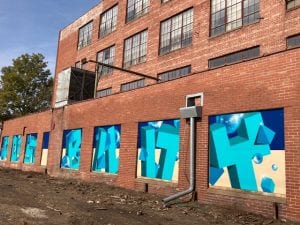
The Renew Moline commissioned mural at the ground floor of the Spiegel Building, 200 20th St., Moline.
at its meeting next Tuesday, March 30.
The plan lays out three strategies that will help shape the future of public art in downtown Moline and creates a strong foundation in the city to support public art.
“Public art in Moline importantly shows a vibrant, growing economy and is reflective of a community emerging from the challenges of the last year,” Mayor Stephanie Acri said in a Friday release. “We are looking forward to seeing the plan and considering its adoption on Tuesday.”
The $50,000 plan was funded primarily by The Moline Foundation, and was completed under the direction of Renew Moline in cooperation with the city. A nine-member Public Art Steering

Amanda Golden, a principal with Designing Local of Columbus, Ohio, led formation of the Moline plan.
Committee (formed in late 2019) guided the consultant selection and recommended Designing Local, based in Columbus, Ohio.
Amanda Golden, a principal in the firm, led the planning process. She is also a certified placemaker, and has produced public art plans in cities nationwide.
Among the first steps recommended in the Moline plan are to adopt a proposed public art ordinance, establish a public art commission, and recommend integrating public art into ongoing city building and infrastructure projects.
On March 24, the Moline Plan Commission endorsed the public art plan, and commission chair Craig Mack (who’s also on the public art steering committee) commended Designing Local on the thoroughness of their work.

Kevin Maynard, executive director of Quad City Arts, is on the nine-member Public Art Steering Committee.
“By endorsing this public art policy, Moline will be the first community in the Quad-Cities to have a formal public art program,” Mack wrote to the City Council. “Diversity of the art work will inspire our residents and will draw visitors to our community.”
He also said that the public art plan should eventually be expanded to include all of Moline.
Kevin Maynard, executive director of Quad City Arts, was a member of the Public Art Steering Committee that guided the development of the plan. He said, “Public art drives creative placemaking, increases civic pride, and helps strengthen a local economy.
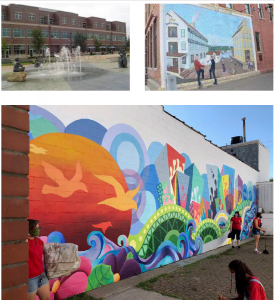
Existing public art in downtown Moline includes the 2020 Metro Arts mural at 1516 6th Ave.
“Pre-Covid, cultural tourism was on the rise and is predicted to return stronger than before and cultural tourists spend nearly twice as much when visiting,” he said. “Additionally, more people are looking at whether a community is rich in the arts when deciding where to locate for a job, especially among younger demographics.”
The plan was developed with a strong public outreach component. A series of “Walkabout Talkabout” public art walks were originally scheduled last April and had to be conducted virtually.
Amanda Golden said, “Even despite challenges presented by the pandemic, we were pleased to have over 200 individuals participate in our activities. We got a lot of great feedback that is reflected in the plan. As an example, we had not listed Sylvan Island as a potential site for art, but we heard about it so often in our community meetings that we added it, and it now appears in the plan as a concept site.”
Golden also expressed her pride in the work, citing significant participation by the community in developing the plan.
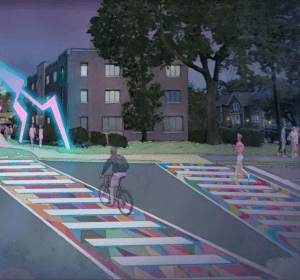
A rendering of potential streetscaping art for downtown Moline in the public art plan.
It includes a multi-pronged funding strategy that is designed to infuse “Cultural
Corridors” with public art, and relies on a mix of public, private and grant funds to fulfill the vision. It also contains seven “Conceptual Projects” at key locations in downtown, with colorful ideas for inspiration.
These concepts were the basis of community engagement, and reflect the feedback from the community about characteristics about art that would be important in those areas.
“The concepts, while illustrated graphically in the plan, are intended to be inspirational,” said Alexandra Elias, President/CEO of Renew Moline. “The art that is ultimately implemented in those locations may look very different from what is shown. The images shown are only to illustrate the possibilities, and the possibilities are endless.”
A unique partnership
“Public art provides meaning to public spaces, reflects the history of a city, adds uniqueness to neighborhoods, and humanizes the built environment,” the plan says.
“Public art lives at the intersection between our past, present, and future, and has the power to transform public spaces. The City of Moline is committed to developing a strong public art program and this plan is an important first step in creating the foundation for the program to

Alexandra Elias is president/CEO of Renew Moline.
grow upon.”
The foreword to the plan – penned by Mayor Acri, Renew Moline board chair Carrie O’Neill, and Moline Foundation board chair Larry Meeske – says: “A unique partnership has made this Public Art and Placemaking Plan possible.
“Together, we have established a vision for downtown. We have laid out our aspirations for corridors and public spaces that are animated and inviting, and specific areas that will be enhanced under this Plan.
“These spaces will be assets to our public realm and our downtown and will make downtown a more vibrant place to live, work, play, visit and learn,” it says. “It directs diversity both in the type of art that will be implemented, and in the people it represents. The ideas contained in the Plan were generated largely by
stakeholders. Despite doing outreach during a pandemic, over 100 individuals participated in various stakeholder meetings, first in person, and then virtually.”
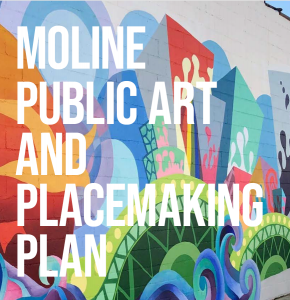
The cover of the new Moline Public Art and Placemaking Plan.
“Building a dynamic urban core animated by public art contributes to economic vitality by creating places where people want to be and to invest,” the foreword says.
“The Plan includes an implementation strategy that offers the opportunity to seek funding through federal, state and local grants along with private and non-profit support; and also uses the development process to focus investments in public art into future development and infrastructure projects. By employing multiple funding sources, the Plan will be both balanced and implemented over time.”
One suggested public art plan envisions a new city riverfront park, under where the old I-74 bridge is. The City Council has voted to endorse the concept of a riverfront park (yet to be designed, funded or constructed), and the new plan notes Schwiebert Park in Rock Island is an example of a successful waterfront park, which is seven acres and cost approximately $10 million.
“Using Schwiebert Park as a standard for the type and quality of improvements, one could expect a 1.5-acre Moline riverfront park to cost about $2.2 million,” the plan says, adding with an
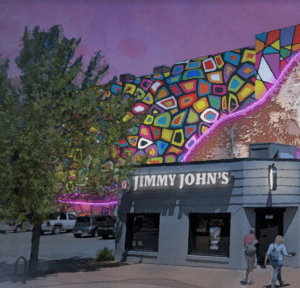
A rendering of what a public mural on the west side of the Analog Arcade building (14th Street and 5th Avenue) would look like
estimated 2% percent for art, $44,000 would be required, for a total project cost of $2,244,000, and new art would be incorporated into the proposed park.
The new plan also outlines basic components for public art at seven downtown locations, with cost estimates:
- Sylvan Island, with environmental art and nature play equipment.
- 19th Street and 7th Avenue, with pedestrian scale artwork to help improve safety and enliven the area.
- River Drive at new I-74 ramp, with a monumental gateway sculpture that could cost $500,000 to $1 million.
- Welcome words (in concrete or other media) at 19th Street and 5th
- 15th Street overpass at River Drive with 15 interactive LED lights.
- A mural at a blank wall on Analog Arcade Bar, 5th Avenue and 14th
- Small lit sculptures at the Q parkway, at northeast corner of 12th Street and 4th Avenue, at new rail station.
Elias of Renew Moline said Friday that formal requests for proposals may be issued from the Public Art Commission for these projects.

Brandon Nees of Davenport completed his downtown Moline mural in October at the Spiegel Building off River Drive.
This past October, Renew Moline led unveiling of a new public art project (part of the downtown master plan) at the vacant Spiegel building, 200 20th St. The commissioned mural, on several ground floor panels, was done by Brandon Nees, a 25-year-old Davenport artist who graduated from Moline High School.
He painted the word “possibility” in big turquoise block letters across seven plywood panels –
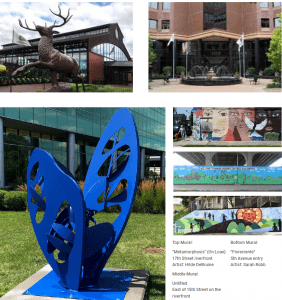
Existing public art in downtown Moline, including the leaping deer sculpture at the John Deere Pavilion and a blue sculpture at the KONE building.
among nine colorful 7.6-foot-by-6.75 feet panels he created for a $10,000 public mural on the boarded-up ground floor of the city-owned Spiegel building off River Drive in downtown Moline.
Through a competitive process led by the city and Renew Moline, Nees’s proposal was chosen from among 28 submissions.
The purpose of the Spiegel mural project was to beautify and draw attention to the building, a city-owned asset and important piece of the historic fabric of downtown. The four-story Spiegel building is also at the center of the redevelopment area created by the $1.2 billion I-74 bridge project.
The public art project is designed to both encourage dialogue about the future development of the area and create curiosity and interest in the building, by imagining the “possibility.”
To see the entire downtown Moline public art plan, click HERE. For more information on Renew, visit www.renewmoline.com/.













Leave a Reply
You must be logged in to post a comment.